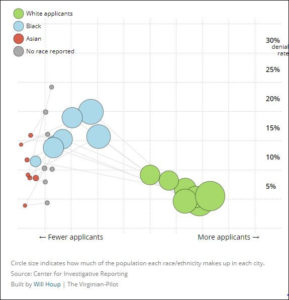
Pseudo-data alleging racial disparities in mortgage lending in Hampton Roads.
The Center for Investigative Reporting has published an in-depth analysis of lending data showing that African-Americans have been denied home loans at a significantly higher rate than whites in 48 out of the 61 metropolitan areas examined. The Virginian-Pilot picked up that research and published an article yesterday stating that African-American homebuyers in Hampton Roads were more than twice as likely than whites to have loans denied.
It just goes to show, if you look for racism hard enough, you’ll find it anywhere and everywhere.
Let’s take two theoretical findings. Let’s say six percent of whites have their loans denied, and 18% of blacks have their loans denied. That means blacks are three times more likely to be denied a mortgage! Now, let’s say that 94% of whites have their loans accepted, and 82% of blacks have their loans accepted. That means whites are only 14% more likely to qualify for a mortgage.
Which one sounds more racist to you? The first statement, right? Of course, the two statements are based on exactly the same data. It’s just that one is framed to make lending patterns look more racist and the other framed to appear the opposite. Which way did the Virginian-Pilot and Center for Investigative Reporting choose to present the data? The way that framed mortgage lending as racist.
Likewise, the investigative report emphasized that racial discrepancies were found in 48 metros, largely overlooking the fact that none were found in 13. Who would be interested in running a headline, “No Sign of Racism in Twenty Percent of American Cities”?
But the problems in the analysis run far deeper. The data is inherently flawed and useless.
The intrepid investigators describe how they adopted a “binary logistic regression” methodology that assesses the relationship between multiple independent variables against a single binary input (whether or not a mortgage was denied). Then it looked at nine different variables:
- Race/ethnicity
- Sex
- Whether or not there was a co-applicant
- Applicant’s income
- Loan amount
- Ratio between loan amount and applicant’s income
- Ratio between median income of the census tract and median income of the metro area
- Racial and ethnic breakdown by percentage for each census tract
- Regulating agency of the lending institution
The authors do concede that they leave out two important variables — credit scores and debt-to-income ratios — because the data is unavailable. However, those are the two of the most important variables of all! If someone has a lousy credit score, regardless of their income or income-to-mortgage ratio, lenders are less likely to finance a mortgage. If someone is loaded up with credit-card debt, student loan debt, or auto loan debt, those other obligations will figure rightly into a bank’s calculations.
The Center for Investigative Reporting notes in its article that, according to U.S. Census Bureau data, the median net worth of African-American families is $9,000, while the median net worth for whites is $132,000. That’s a real disparity, and it’s based on complex historical reasons arising from the legacy of slavery, Jim Crow, and the Great Society. But racially blind lending algorithms look at credit scores, net worth, and debt obligations — not the historical reasons behind them.
In sum, running a binary logistic regression without including the most critical lending variables is a worthless exercise, and making broad indictments of the mortgage banking industry on the basis of such worthless findings is reckless. Race relations are frayed enough as it is, and the last thing the country needs is another “study” alleging discrimination where it does not exist, and engendering resentment that is unwarranted. It’s bad enough that Russian bots are spreading fake news to intensify racial animosity. We don’t need journalists feeding the fire.
Like the boy who cries wolf, such studies deeply damage the credibility of those who issue the alarms. One is tempted to assume that the methodology of every study showing institutional racism is just as shoddy and the ideological biases of the authors are just as blatant. There is a danger that many people will ignore instances in which claims of racism actually are justified.
If a properly conducted study adjusted for credit scores, net worth and indebtedness, who knows, it might show that residual racism still exists. But after enough studies like this, millions of Americans would slough it off as more noise from social justice warriors passing themselves off as journalists.


